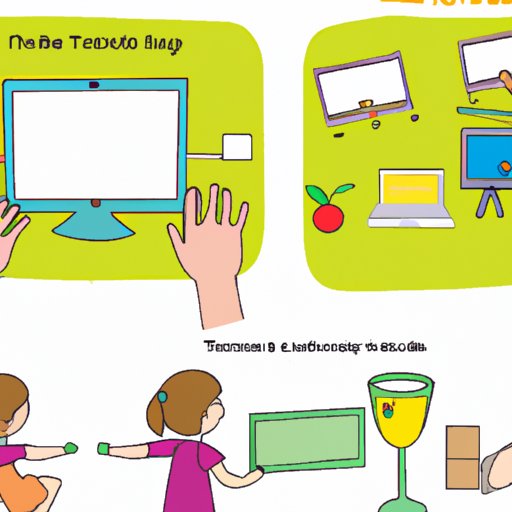Introduction
Technology is an ever-evolving field that has become increasingly important in our lives. It is important for young students to learn how to use technology effectively so they can be better prepared for their future. Teaching technology to elementary students can help them become more tech-savvy and develop the skills they need to succeed. In this article, we will explore some tips and ideas on how to teach technology to elementary students.
Use Visual Cues and Diagrams to Explain Concepts
Visual cues and diagrams are a great way to explain complex concepts to elementary students. Using visuals can help students understand the material more easily and provide a more engaging learning experience. Visuals are also helpful for those who may have difficulty understanding abstract concepts.
One of the most effective visual cues is the use of flowcharts. Flowcharts provide a visual representation of a process or sequence of events. This makes it easier for students to follow along and understand what is happening. Additionally, flowcharts can be used to show the relationship between different elements, which can help students make connections between different concepts.
Other examples of visual cues include diagrams, infographics, and charts. These types of visuals can help students visualize complex concepts and can be used to compare and contrast different ideas. By using visuals, students can be more engaged in the learning process and gain a better understanding of the material.
Provide Hands-on Activities with Technology
Hands-on activities are a great way to engage students and help them learn how to use technology. By providing hands-on activities, students can get a better understanding of the concepts being taught and gain practical experience. Additionally, hands-on activities can help promote collaboration among students as they work together to complete tasks.
One example of a hands-on activity is to have students create a simple website. This can be done by using a platform such as Wix or Weebly, which allow students to easily create a website without any coding knowledge. This activity helps students understand the basics of web design and gives them an opportunity to apply their knowledge in a real-world setting. Other examples of hands-on activities include creating a presentation using PowerPoint, designing a logo using Adobe Illustrator, or programming a robot using Scratch.
Introduce Technology in a Fun Way, Such as Through Games
Introducing technology through games can be a great way to make learning fun and engaging. Games are a great way to introduce technology concepts in a more relaxed and enjoyable atmosphere. This can help students stay focused and motivated while learning. Additionally, games can be used to reinforce concepts that have already been taught.
One example of a technology-related game is a coding game. Coding games are great for introducing students to programming concepts and giving them an opportunity to practice their coding skills. There are many coding games available online that can be used to teach students the basics of coding. Other examples of technology-related games include educational video games, board games, and simulations.

Structure Lessons Around Projects that Integrate Technology
Structuring lessons around projects that integrate technology can be a great way to help students understand how technology works in the real world. Projects can be used to demonstrate how technology can be used to solve problems and create solutions. Additionally, projects can help students understand the importance of collaboration and working together to accomplish tasks.
One example of a technology-integrated project is to have students create a website or app. This project can help students understand the process of developing a website or app from start to finish and give them an opportunity to apply their knowledge in a real-world setting. Other examples of technology-integrated projects include creating a video, building a robot, or designing a logo.

Involve Parents in the Learning Process
Involving parents in the learning process can be a great way to engage students and help them learn more effectively. Parents can provide valuable insight and support to students as they learn how to use technology. Additionally, parents can serve as a resource for students if they have any questions or need additional help with the material.
One example of involving parents in the learning process is to have them join the classroom for a technology-related activity. This can be a great way for parents to get involved and observe how their children are using technology. Other examples of involving parents in the learning process include having them participate in video conference calls, helping with homework assignments, and attending parent-teacher conferences.
Utilize Online Resources, Such as Videos and Tutorials
Online resources, such as videos and tutorials, can be a great way to supplement traditional teaching methods. These types of resources can help students learn at their own pace and can be used to reinforce concepts that have already been taught. Additionally, online resources can be used to provide students with more information and allow them to explore topics in greater depth.
One example of an online resource is YouTube. YouTube is a great source for educational videos that can be used to teach a variety of topics. Additionally, there are many tutorials and guides available on YouTube that can be used to teach specific topics or provide step-by-step instructions. Other examples of online resources include websites, articles, and blogs.
Conclusion
Teaching technology to elementary students can be a challenging but rewarding task. By using visual cues, providing hands-on activities, introducing technology through games, structuring lessons around projects, involving parents, and utilizing online resources, teachers can effectively teach technology to elementary students. With these tips and ideas, teachers can help their students become more tech-savvy and develop the skills they need to succeed.
(Note: Is this article not meeting your expectations? Do you have knowledge or insights to share? Unlock new opportunities and expand your reach by joining our authors team. Click Registration to join us and share your expertise with our readers.)
